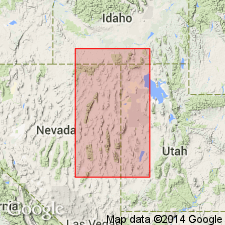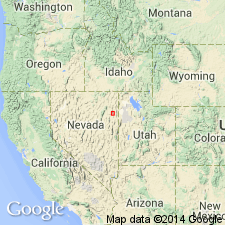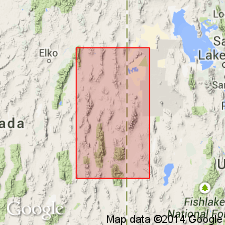
- Usage in publication:
-
- Indian Canyon Formation
- Modifications:
-
- Named
- Dominant lithology:
-
- Dolomite
- Quartzite
- Siltstone
- Chert
- AAPG geologic province:
-
- Great Basin province
Summary:
Name applied to some cherty, sandy, and silty, gray, brown dolomite, dolomitic orthoquartzite, and dolomitic siltstone above Plympton Formation and beneath Gerster Formation; all 3 formations assigned to Park City Group. Type section is in Indian Canyon, Pequop Mountains, sec. 21, T31N, R65E, Elko Co., NV. Areal extent map shows formation in adjacent White Pine Co., NV, and in westernmost Box Elder and Tooele Cos., UT, all in Great Basin province. This sequence was assigned to Phosphoria Formation, but it has little similarity to Phosphoria except for its high chert content. Three columnar sections representing measured sections shown; is 710 ft thick at its type, 475 ft thick in Gold Hill district, UT, and 400 ft thick in Leppy Range at the NV-UT border. Lower contact placed at top of a limestone or dolomite (Plympton) beneath orthoquartzite (Indian Canyon); upper contact placed at top of orthoquartzite (Indian Canyon) with fossiliferous limestone (Gerster). Orthoquartzites and siltstones weather red-brown. Dolomite weathers gray. Bedded chert is black. Nodular chert makes up 1-2 percent to 60 percent of unit. Algae abundant. Echinoid spines. No diagnostic fossils. Thought to be Wordian, Permian, because it lies between Wordian Plympton and upper Wordian and Capitanian Gerster. Correlation chart.
Source: GNU records (USGS DDS-6; Denver GNULEX).

- Usage in publication:
-
- Indian Canyon Formation
- Modifications:
-
- Not used
Summary:
The base of unit 4 of the Plympton Formation is thought to be the base of the Indian Canyon Formation. The Indian Canyon is locally mappable, but not as a separate formation. The top of the Indian Canyon not identified.
Source: GNU records (USGS DDS-6; Denver GNULEX).

- Usage in publication:
-
- Indian Canyon Formation
- Modifications:
-
- Not used
Summary:
Rocks of unit 5 of Plympton Formation of Park City Group are variable; they include dolomite, bedded chert, gypsum, possibly collapse breccias, and dolomitic siltstone. The name Indian Canyon Formation (of Park City Group) was applied in the southern Pequop Mountains, but that name has not been used. Report area extends from Medicine Lodge to southern Pequop Mountains, NV to Gold Hill and Confusion Range, UT, Great Basin province where Park City Group of late Leonardian to early Guadalupian, Early Permian age can be divided into (ascending): Kaibab Limestone, Plympton Formation, and Gerster Limestone Cross sections. Isopach map of Gerster Limestone. Faunal lists.
Source: GNU records (USGS DDS-6; Denver GNULEX).
For more information, please contact Nancy Stamm, Geologic Names Committee Secretary.
Asterisk (*) indicates published by U.S. Geological Survey authors.
"No current usage" (†) implies that a name has been abandoned or has fallen into disuse. Former usage and, if known, replacement name given in parentheses ( ).
Slash (/) indicates name conflicts with nomenclatural guidelines (CSN, 1933; ACSN, 1961, 1970; NACSN, 1983, 2005, 2021). May be explained within brackets ([ ]).

